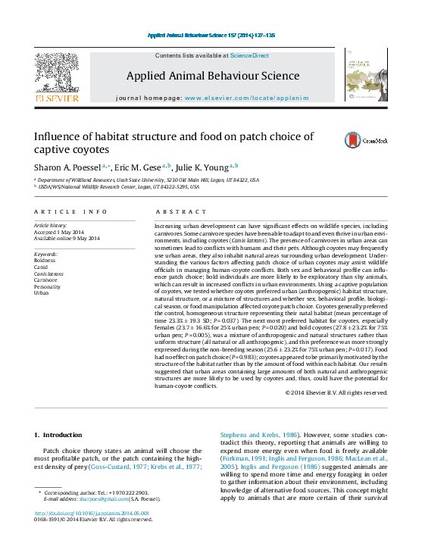
Applied Animal Behaviour Science 157 (2014) 127–136.
Increasing urban development can have significant effects on wildlife species, includingcarnivores. Some carnivore species have been able to adapt to and even thrive in urban envi-ronments, including coyotes (Canis latrans). The presence of carnivores in urban areas cansometimes lead to conflicts with humans and their pets. Although coyotes may frequentlyuse urban areas, they also inhabit natural areas surrounding urban development. Under-standing the various factors affecting patch choice of urban coyotes may assist wildlifeofficials in managing human-coyote conflicts. Both sex and behavioral profile can influ-ence patch choice; bold individuals are more likely to be exploratory than shy animals,which can result in increased conflicts in urban environments. Using a captive populationof coyotes, we tested whether coyotes preferred urban (anthropogenic) habitat structure,natural structure, or a mixture of structures and whether sex, behavioral profile, biologi-cal season, or food manipulation affected coyote patch choice. Coyotes generally preferredthe control, homogeneous structure representing their natal habitat (mean percentage oftime 23.3% ± 19.3 SD; P = 0.037). The next most preferred habitat for coyotes, especiallyfemales (23.7 ± 16.6% for 25% urban pen; P = 0.020) and bold coyotes (27.8 ± 23.2% for 75%urban pen; P = 0.005), was a mixture of anthropogenic and natural structures rather thanuniform structure (all natural or all anthropogenic), and this preference was more stronglyexpressed during the non-breeding season (25.6 ± 23.2% for 75% urban pen; P = 0.017). Foodhad no effect on patch choice (P = 0.983); coyotes appeared to be primarily motivated by thestructure of the habitat rather than by the amount of food within each habitat. Our resultssuggested that urban areas containing large amounts of both natural and anthropogenicstructures are more likely to be used by coyotes and, thus, could have the potential forhuman-coyote conflicts.
Available at: http://works.bepress.com/julie_young1/240/

U.S. government work.